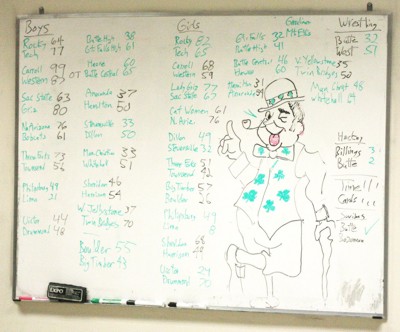The basketball coaches whiteboard is a place of inspiration, of attention to detail, and motivation before the start of the game.
No matter the level of competition, basketball starts and ends in the lockeroom. In every lockeroom, a whiteboard exists. This whiteboard is filled with everything vital and important to the game. After the game is over and the players have long left, the coach will usually sit alone and study the whiteboard.
Basketball coaches whiteboards are like a sanctuary for coaches. Before the game, the board must contain all useful information for the game about to take place. After the game, the coach should study the whiteboard and decide if the game plan and motivation worked.
What should I change next time? What’s was my biggest mistake? What would I say worked well? Did the players respond to this particular quote? All these questions are asked and studied by the coach.
Basketball coaches’ whiteboards first start out blank – hours before the game. The coach sits down and studies the opponent’s roster. Likely the coach or assistant coach has scouted the other team and know about their personnel. Sometimes the coach has not seen the team, but can rely on statistics to study which players are crucial to that team’s success.

Most teams stick with a consistent starting lineup. More than likely your team does the same. But sometimes you need to adjust the starting lineup to meet the other team’s physically or you want to exploit a match-up. Say for example, that the opponent you are facing is very big and strong.
You do not have the strength and size to match-up. What could you do? How about benching one of your big men and starting another guard? The scenario will give them free reign to score inside, but their size and power will not keep up with your team’s speed and quickness.
The first thing you jot down on the board (in one of the top corners) should be the five opposing starters. Make sure you list their name and number. Also, write down certain attributes and skills of each starter. This is especially important if the team is not very familiar with the opponent. Mention if they are a shooter or defender.
Do they have an offensive move they rely on a lot? Which player grabs the most rebounds? Does anybody on the team shoot or dribble dominantly left-handed? Mention that because most players automatically assume their opponent dribbles and shoots right-handed. Also, list any players who come off the bench and provide solid minutes to the team.
After you list the opponent’s key players, jot down your five starters for the night and their defensive assignment. Make sure you provide key information on the team’s top scorer so your top defender will know as much as he can about the player before tip-off.
It’s always helpful to label 4-5 keys of the game. This can range from “outrebound are opponent” to “less than eight turnovers.” Make sure you list a few keys to the game and go over them in great detail. They are the keys to winning after all.
If you installed a new offensive play or defensive formation, overview it one more time just to make sure every team member has it firm in their head.
Also, I always found it highly motivational when I was a player to see the coach write down an inspirational quote or to cite a fact of motivation for the game. Part of the pre-game preparation is finding out how to spark your players and ignite their inner emotions. Think about great quotes, great statements, or bulletin board material such as a newspaper columnist saying the team isn’t worth squat.
Return from Basketball Coaches Whiteboard to Basketball Coaches
Return from Basketball Coaches Whiteboard to Best Basketball Tips

